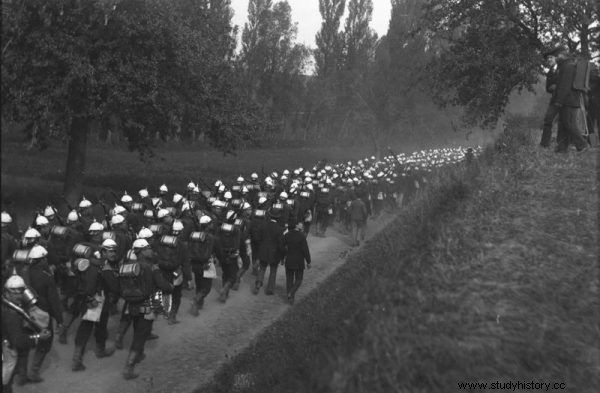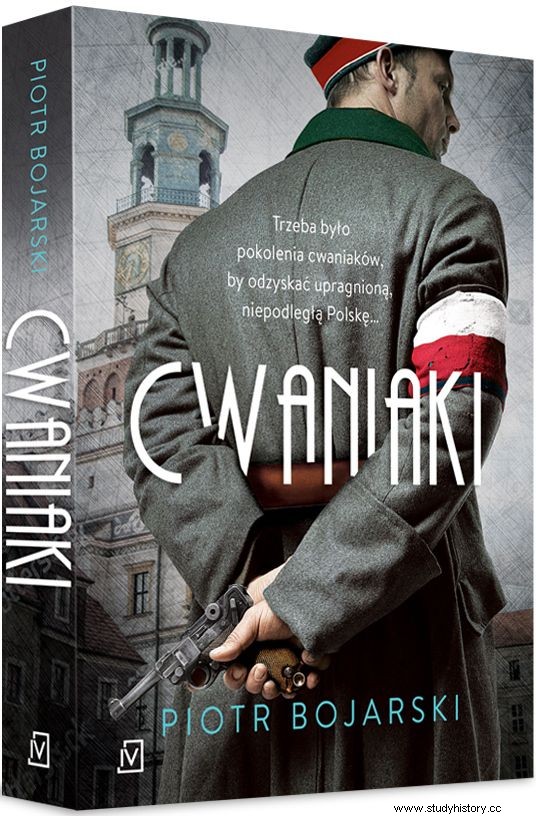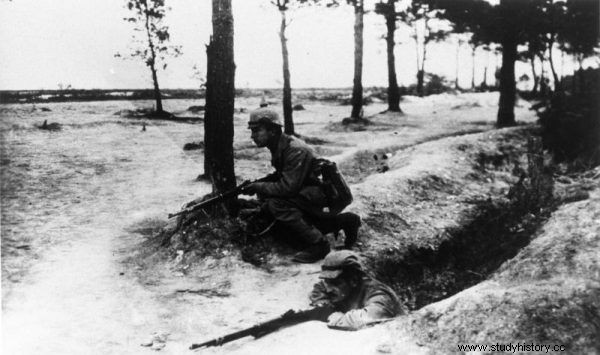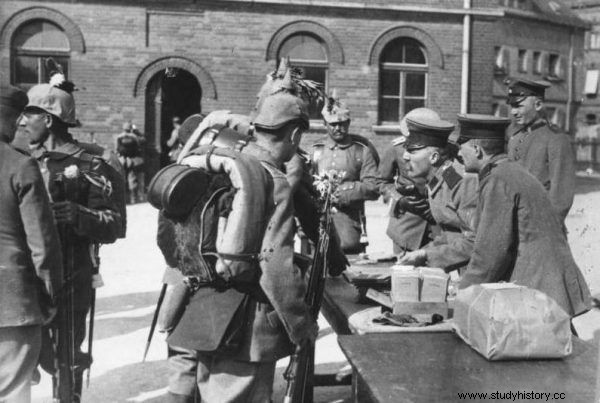They came from Greater Poland, Silesia, Pomerania, Warmia and Mazury. In 1914, they were dressed in Feldgrau uniforms, with pickelhaubs pressed over their heads and sent to war. They came to the front, fought, sometimes died. Others replaced them. How many It's impossible to count exactly, but we can try to estimate their number.
"I went to war in a German uniform," recalled Bohdan Hulewicz, later a colonel in the Polish Army. As early as 1914 he tried to explain to the French why he attacked their country:
I'm not German. I am a Pole (...) from Poznań. (…) Germany rules in Poznań. Me and all the local youth were drafted into the army. Nobody asked us if we wanted to go to war or not.
He was telling the truth - Poles born in Greater Poland, Silesia, Pomerania, Warmia and Masuria were citizens of the German Empire and were subject to military service. Even in the 19th century, they fought short and unquestionably victorious wars under the German banner with Denmark, Austria and finally with France, although not everyone paid off. The brave deeds of Polish conscripts and the ingratitude of the partitioner were described in the novella of 1882 "Bartek the winner" by Henryk Sienkiewicz.
Action germanization?
The writer did not like the Germans, but it is hard to blame him in the Kulturkampf era. The Kaiser army also tried to Germanize Polish soldiers, forbidding the use of their mother tongue. Deliberate "brainwashing"? Not necessarily.

The methods used in the imperial army served not only Germanization, but also the modernization of society. In the photo from 1888, soldiers on maneuvers.
Researcher of the history of Silesia, prof. Ryszard Kaczmarek noted that although many German officers had a sense of civilization superiority over Poles , the methods used in the military were simply to lead to the modernization of society - a fact, in the German fashion and with Teutonic charm.
The reason for the ban on speaking in Polish was very pragmatic. It turned out that the conscripts had to be taught German - contrary to appearances, a large part of the recruits knew it poorly. Certain exceptions were also allowed. For example, in the 23rd Nysa Infantry Regiment at the end of the 19th century during the mass, sermons were preached in Polish so that the imperial soldiers would understand what was said to them .
There was also no persecution due to their origin and Poles received officer ranks. It is worth remembering, however, that in the German army our compatriots very rarely held command positions. Meanwhile, in the remaining partitioning armies - the Austro-Hungarian and Russian - the road to a military career was open to them.
Silesian pie - the terror of the French
Mobilization shortly after the outbreak of World War I was carried out quickly and efficiently. "The local and local youth are standing, supported by a large group of reservists from Pleszew and the local area, to fulfill their heavy duty (...) On the emperor's order to become a victim of the juggernaut of war ” - was quoted by prof. Kaczmarek example from Śrem in Greater Poland, where the 2nd Battalion of the 47th Infantry Regiment was stationed.

This article was inspired by a novel by Piotr Bojarski entitled "Cwaniaki" . Describing the fate of Poznań residents in German uniforms who are preparing the Greater Poland Uprising.
Some mobilized units with Polish conscripts even managed to take part in the Battle of the Marne at the beginning of September 1914. However, one hundred years later, it is difficult to trace their fate. Although the memory of the Kaiser's army service was present in the family memories of the inhabitants of the Prussian partition, in practice it was removed from the collective consciousness. According to prof. Kaczmarek:
There are no separate "Polish" regiments, divisions or brigades, as it was in the Russian and Austrian armies. Poles in the Kaiser's army serve as soldiers, non-commissioned officers, rarely officers , in ethnically mixed units that are part of German troops fighting on almost all fronts of the First World War, but they cannot be called Polish. They do not have Polish distinctions, special badges on their uniforms, what's more, they are forbidden to use the Polish language.
The easiest way to look for traces of Poles in the German ranks is by using the language. And so, for example, the Krakow's "Ilustrowany Kuryer Codzienny" on October 27, 1914, after "Gazeta Gdańska" (which in turn quoted German newspapers), reported that the French were very afraid of units composed of Polish Upper Silesian conscripts, because they were going to attack the bayonets with a shout of "Hopla, puff, to the side with his mouth!" .
Eye to eye with compatriots
The greatest tragedy of our compatriots, however, was not the necessity to fight in foreign uniforms, but the fact that at times this fight turned out to be fratricidal. Already at the beginning of December 1914, Poles met at Arras. Unfortunately - in hostile trenches . On the one hand, Polish conscripts in German uniforms, opposite, in the French trenches - volunteers serving in the branch of the Foreign Legion, called the Bayonians.

Poles in German and French uniforms faced each other at Arras.
The latter raised a banner with a white eagle and tried to establish contact with "their people". They talked in Polish, sang songs - all this to encourage their compatriots to switch to the Allied side. The German command decided not to risk it. Polish conscripts were transferred to another section of the front, where they were not threatened with agitation.
There were other meetings as well. Writer and literary critic Cezary Jellenta from Warsaw wrote in his diary at the end of October 1914 that German soldiers were not always Germans . He saw with his own eyes the prisoners of war being led - Poles in the uniforms of the imperial army:
Some people go sad (...), some smile at the crowd, talk or try to chat in Polish. The good Warsaw folk, despite their mocking shouts, enjoys their peculiarities, gives them cigarettes, and has a brother. In this way, the partial unification of Poland is already taking place.
Similar observations were made by delegates and delegates of the Committee for the Protection of Prisoners in Warsaw, who provided aid to Kaiser prisoners. They realized that their "pupils" are a group of "Poznanians, Silesians and Masurians in foreign uniforms, but their own and dear ones with heart and speech ".

Poles in German uniforms also fought on the Eastern Front. In the photo from 1917, a group of German prisoners of war. I wonder if there were any people from Poznań or Silesians among them?
Polish blood shed for the German cause
Polish soldiers - like most of the imperial army - served mainly in Western Europe:in Belgium, Luxembourg and France. They took part in heavy and bloody battles at Verdun and on the Somme. Sometimes, however, they were transferred to the Eastern or Italian front. The losses were analogous to those suffered by "ethnic" German troops, and therefore very large. The foot soldiers were in the worst situation . With the distance from the front line - in cavalry or artillery - the chances of survival increased.
Memories left by Poles participating in the Great War on the German side, even after a hundred years, can cause shivers. For example, a soldier from Greater Poland reported:
The fire intensifies with each passing moment. (…) The dead bodies are already lying like sheaves in the field. A trumpet is heard. The signal to attack. (...) We're running. A dozen or so are raining. Every step new people fall. (…) The dying croak, twitch, roll their eyes. In unbelievable positions (…) those who don't need anything anymore ”
In turn, a conscript from Pomerania, who witnessed the death of a group of German soldiers, described:“Maybe five, maybe six. Whistle and Crash; A grenade struck almost in the middle of this cluster. The earth, shreds of clothing, parts of the human body fall on us. I was speechless! There was no trace of those people ”

This article was inspired by a novel by Piotr Bojarski entitled "Cwaniaki" . Describing the fate of Poznań residents in German uniforms who are preparing the Greater Poland Uprising.
. The clashes at the very beginning of the war in 1914, when the commanders were only learning about the firepower of artillery and machine guns, brought the greatest deaths, and in 1916, when both sides tried to bleed the enemy out at Verdun and on the Somme. Then it was also revealed that recruits were recruited into the units too quickly and the training was insufficient . One of the "lucky" survivors recalled:
We behaved quite inappropriately. For example, when the first grenade hit nearby, I watched in amazement that everyone was throwing themselves to the ground. It was only at the thought that I might be punished - I fell down when others were already getting up.
No wonder that of his group of 45 novices who were sent to supplement Flanders, 36 were killed or injured after two days of fighting.
A foreign-sounding name
However, it is impossible to precisely determine the total number of fallen Poles in German uniforms, because on the lists of losses - wounded and killed - they were most often referred to according to their citizenship as Germans . They could also be confusing the names - the fact that someone's sounded Polish did not mean that the soldier felt like our compatriot - and vice versa. Many of the owners of German surnames were declared Poles.

During the Great War, about 800,000 Poles were conscripted into the German army.
Aleksandra Kacprzak and Mariusz Żebrowski from Grudziądz are trying to explain the fate of at least some of the fallen, wounded and missing who were placed on the Deutsche Verlustlisten. In the Gothic lists of the List of Losses of the Prussian Army there are names such as:Kosbierski, Kendiorski, Koslowski , as well as names, ranks, names and numbers of units, counties of origin, battlefields and information about what happened to a given soldier.
Thanks to their work, some families found their relatives - great-great-grandparents or brothers of their great-grandfathers - and learned about their suffering during the Great War. Still, the fate of many of our countrymen who fought under Kaiser banners remains unknown. We don't know how many actually there were.
In the interwar period, when the topic was still fresh, it was estimated that 780-800 thousand Poles were mobilized into the German army . 108–110,000 of them died in the occupant's uniforms, and twice as many were wounded or became war invalids. To what extent are these data consistent with the facts? Well, we'll probably never know that.
Inspiration:
This article was inspired by a novel by Piotr Bojarski entitled "Cwaniaki" . Describing the fate of Poznań residents in German uniforms, who are preparing the Greater Poland Uprising in the ranks of the Polish Military Organization of the Prussian Partition.
Buy the book at a discount on empik.com

